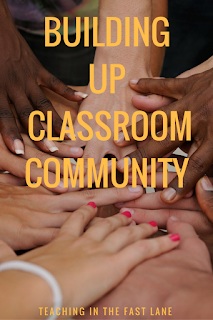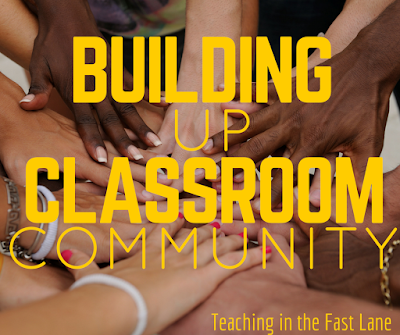Classrooms are tough. They are microcosms of our world and exhibit all of the same challenges that our society displays, but they have one distinct advantage. That advantage is you. As a teacher, you have a unique capability, and responsibility, to make sure that every student is included and feels as though they belong to the classroom community.
In my classroom community comes first. It is only after students are able to feel at home and safe in the classroom environment that I am willing to dig into academics. I pride myself on the relationships that I have built with students, but I am not perfect, and neither are those relationships. A classroom community is always growing and evolving, and we have to evolve with it.
It is with this goal that I thought about how I would go about building an ideal classroom community.
Start with Communication
This seems like such a simple idea, but yet it gets forgotten so often. A common adage says, “Communication is a two-way street,” however this does not really work in a classroom. Instead, classroom communication is more like a spaghetti bowl. You have to have open lines of communication from the teacher to the student along with the student’s family, and other professionals in the school setting. In order to make communication truly open all of these parties have to be involved in the conversation with the common goal of supporting the student.
Communication lines cannot end at the classroom door but instead MUST extend to their home lives as well in order to truly value the student.
Celebrate Students
Part of a community is honoring one another’s accomplishments, heritage, and history.
Look to your students’ families for guidance in this area, but do not expect them to give you an hour-long lesson in their ethnicity and cultural viewpoint. Instead, through your already established lines of communication ask if they have anything they would like to share. Students, especially in elementary school, often have great pride in sharing their family’s experience with the class and it lifts them up even higher when their family members are involved.
Communities also celebrate one anther’s accomplishments in and out of the classroom. For some students this may mean celebrating losing a tooth, winning a soccer game, or mastering their multiplication facts. The truth of the matter is if a student is excited about something, the whole community should be too.
There really are no accomplishments too small for celebration, because remember our students are children who deserve to be celebrated and built up every day.
Include Character Education
Sometimes we get so caught up in academics that we forget about the tiny humans that we are shaping in every way every day. Character education is a huge part of the classroom and should be taught as a core subject in my opinion.
One of the very best ways that I know to teach character education is through shared read alouds followed by thoughtful discussions. There are so many wonderful books that fit the bill, but my favorites are:
(These links are Amazon affiliate links, which means I make a small commission if you choose to purchase, but your price is not affected)
A Chair for My Mother
Chicken Sunday
The Other Side
Pink and Say
Wilfred Gordon McDonald Partridge
Regardless of what book you choose, the discussion with your students about character is where the magic is at.
Be Inclusive with Cooperative Learning Strategies
One of my favorite community building mainstays is using cooperative learning strategies every day, and every lesson possible. The idea behind cooperative learning is that it is just that, cooperative. This means that students are working with one another in pairs, cooperative groups, and whole class. As the teacher, you build in different groupings so that students are working with different sets of classmates throughout the day.
You can read more about cooperative learning strategies I use for Team Building and Class Building that also integrate content for a double whammy of goodness in these posts.
Additionally, I have a FREE Jigsaw Method Activity to help teach about the character traits of compassion, empathy, respect, courage, and inclusion that I know you and your students will just love!
Teach Empathy Through Historical Contexts
Empathy is a hard, hard concept to grasp, and if I am being honest I am not sure that it can be taught. BUT I will do my best to do so regardless of the outcome because in today’s world, we have to try.
All of these experiences give students a new perspective and way of viewing historical events.
Make Sure Your Classroom Community is Inclusive
Perhaps the most vital part of a classroom community is its inclusiveness. Every student should feel not only that they belong, but also that they are a valued part of the community.
There are so many ways to accomplish this. A few that have been popular lately, and for good reason are the #Iwishmyteacherknew campaign and the four names campaign.
#IWishMyTeacherKnew
 #Iwishmyteacherknew is so silly, simple that I smack myself upside the head thinking that I didn’t do it from day one. It is exactly what it sounds like. Students each write a letter to their teacher telling them what they wish they knew. There are many templates out there to make this easy. I just used a piece of notebook paper with my students. Reading their letters was really eye-opening. Even the most outspoken students had things that they had never mentioned to me. I would encourage you to take part in this practice. It is heartbreaking and uplifting all at the same time.
#Iwishmyteacherknew is so silly, simple that I smack myself upside the head thinking that I didn’t do it from day one. It is exactly what it sounds like. Students each write a letter to their teacher telling them what they wish they knew. There are many templates out there to make this easy. I just used a piece of notebook paper with my students. Reading their letters was really eye-opening. Even the most outspoken students had things that they had never mentioned to me. I would encourage you to take part in this practice. It is heartbreaking and uplifting all at the same time.
Four Names Campaign
The four names campaign I am sure has another name. It is just what I called it in my classroom. I learned about this method in a grad school class and then used it every year after that. It is also pretty basic. You ask each student to write down the names of four students they would like to work with in order from most wanted to least. Then collect all the names. You then tally how many times a student’s name was written down and see how the tallies fall. Students with many tallies are well liked and respected by their peers and so forth.
The key is what you do with this information. My job as the teacher was to take the students that fell in the bottom third of tallies and build in ways for them to have meaningful interactions with their peers to improve their “status.” The goal was to have tallies spread fairly evenly throughout the class and to never have anyone who received way fewer tallies than others.
At the beginning of the year, or whenever you started this system, I would have students write and turn in their four names every Friday. Then throughout the year, we would slow it to every other week. Then once a month if the tallies were being evenly spread.
The moral of the story at the end of the day is that our classrooms are about our students. They should be what we think about every moment of the school day, and sometimes afterward too. We want them to feel loved, encouraged, welcome, and safe in our communities. It is all about them.
Want more ideas for creating a positive classroom with a classroom management makeover? Check out this course from Teacher Trap!



